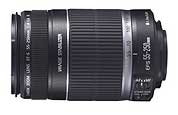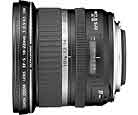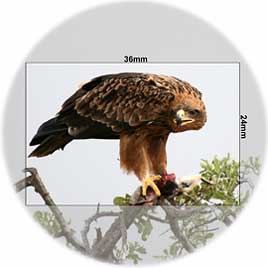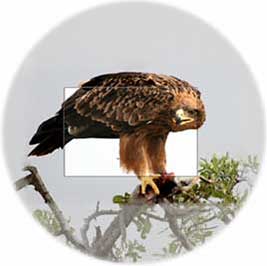Contact Details: Scotch Macaskill, Dirt Road Traders, Currys Post Road, Howick, KwaZulu-Natal, South Africa. Tel: +27 (0)82 578 2329. Privacy: Your privacy is guaranteed. See our Privacy Policy for more. This site accepts advertising and other forms of compensation - see Disclosure and Advertising for details. Site updated: 2022. Copyright © 2002 - 2022 Scotch Macaskill

| ||||||||||
|
||||||||||
|
See Also: |
Canon EF-S Lenses

Canon EF-S lenses are made specifically for use with Canon EOS digital SLR cameras that have the smaller APS-C format sensor (also referred to as "sub full-frame sensor"). Here is the current lineup of Canon digital cameras with APS-C format sensors that can take Canon EF-S lenses:
APS-C sensors are 22.5 x 15mm in size. This is smaller than a full-frame sensor, which is 36 x 24mm in size (the same size as a 35mm negative or transparency). The smaller sensor, when used with a normal Canon EF lens, has the effect of cropping the image (more fully explained below). To counteract this, Canon EF-S lenses were launched in 2003.
Regular Canon lenses come with the designation "EF", which stands for electro focus. These lenses, introduced in 1987 to replace the older mechanical mount FD lenses, were originally designed for use with Canon EOS 35mm film cameras. This means the circular image cast by the lens had to cover a rectangle the size of a 36 x 24mm negative. Fortunately EF lenses are compatible with Canon's entire range of EOS single lens reflex cameras, including its digital SLR cameras. Of these, only the Canon EOS 1Ds and 5D range have full-frame sensors the same size as a negative. The majority of Canon's digital SLRs, however, have smaller sensors. Because sensors are expensive to manufacture, smaller sensors meant affordable digital SLR cameras, like the groundbreaking Canon EOS Digital Rebel introduced in 2003, could be marketed to photographers. However, using smaller sensors has far-reaching photographic consequences. Canon EF lenses, when fitted to cameras with these smaller sensors, cast an image that appears magnified, filling more of the frame than would be the case with a full-frame sensor. This effect (called "crop factor", "lens magnification factor" or "focal length conversion factor") is illustrated in the two images below. The left one shows how a circular image cast by the EF lens is captured on a full-frame sensor, while the other shows the effect of using the same lens on a camera with an APS-C sensor. It's clear the image is now too big for the sensor and has effectively been cropped.
To make sure the whole image fits on the sensor, one either has to move further back from the subject until it can fit in the frame, or change to a shorter focal length lens with less magnifying power. This lens magnification factor is great for photographers using telephoto lenses, as they can now fill the frame of a Canon 550D with a shorter tele lens than would be required if they were using a full-frame camera. In practical terms, it's similar to using a 1.6x converter on the lens. But if this is a boon when shooting with tele lenses, the converse applies when using wide angle lenses. Suddenly that 24mm wide angle that produces dramatic landscapes is no longer so wide and has been "lengthened" by 60%, turning it into a 38.4mm lens (24 x 1.6 = 38.4). Canon realized it had to provide photographers using sub full-frame cameras with additional wide angle options. The result -- a new EF-S mount and range of matching Canon EF-S lenses, aimed at countering the magnification factor on the wide angle side. While EF-S lenses don't eliminate the magnification factor -- the camera's sensor is still smaller so the image will still appear magnified -- their design allows for extreme or ultra wide angle lenses to be manufactured at affordable prices. So a lens that would be classed as ultra wide if used on a full-frame SLR, like the EF-S 17-55mm f/2.8 IS USM, is akin to using a 27-88mm lens when attached to a Canon EOS 40D. "Equivalent" Focal LengthIt is important to understand that the magnification factor still applies to EF-S lenses, which is why an "equivalent" or "apparent" focal length is often provided in the lens description (see list of EF-S lenses below). While the majority of EF-S lenses produced so far are aimed at providing greater flexibility on the wide angle side -- for example the ultra wide EF-S 10-22mm f/3.5-4.5 USM lens (equivalent focal length of 16-35) -- Canon are also producing EF-S lenses that equate more to standard zooms and even telephoto zooms. Canon's Digital Rebels like the XSi (450D) or T1i (500D) are usually offered with the EF-S 18-55mm f3.5-5.6 IS zoom lens as a "standard" lens. The equivalent focal length of this lens is 28.8-88mm, making it a pretty useful standard zoom, with focal lengths from moderate wide angle to short telephoto. The lens is also image-stabilized, an added bonus particularly at the longer end, or when shooting in low light at all focal lengths. Because EF-S lenses have to cover a smaller sized sensor, the circular image they cast can also be smaller than that cast by an EF lens. This means EF-S lenses are more compact and lighter than their big brothers. For example, Canon's EF-S 55-250mm f/4.5-5.6 IS zoom lens is only 4.3" (108mm) long, yet fills the frame of a 40D as would an 88-400mm lens on a 5D body. According to Wikipedia, the "S" in EF-S stands for "short back focus", which means that the rear element of the lens is closer to the image sensor than on regular 35mm SLR cameras. The proximity of the rear element to the image sensor greatly enhances the possibilities for wide angle and very wide angle lenses, enabling them to be made smaller, lighter (containing less glass), faster (larger aperture) and less expensive. Because of their design and the position of the rear element, EF-S lenses cannot be used on 35mm film cameras, on full-frame digital cameras, or on digital cameras with APS-H sensors (Canon EOS 1D family) and it's physically not possible to mount them on these cameras. Canon EF-S Lens LineupBelow is the current lineup of EF-S lenses, with their equivalent focal length in brackets.
Return to Canon Lens Reports |
|||||||||
|
|
||||||||||

